Introduction: In this article, Mary Harrell-Sesniak writes about a family treasure of particular interest to genealogists: heirloom quilts. Mary is a genealogist, author and editor with a strong technology background.
Heirloom quilts and coverlets are comfort for the soul. They tell many a tale of family history, so it comes as no surprise that genealogists and quilting go hand in hand.
Perhaps an heirloom quilt has passed down through your family, as some have in mine.
Emalena’s Quilt
One such quilt in my home was made by Emalena, our family baby sitter.
She was a single woman who remained single until late in life. She treated us like her own children, and gave us many of her beautiful quilts. This one, fashioned in the traditional wedding ring pattern, became a present for my parents.
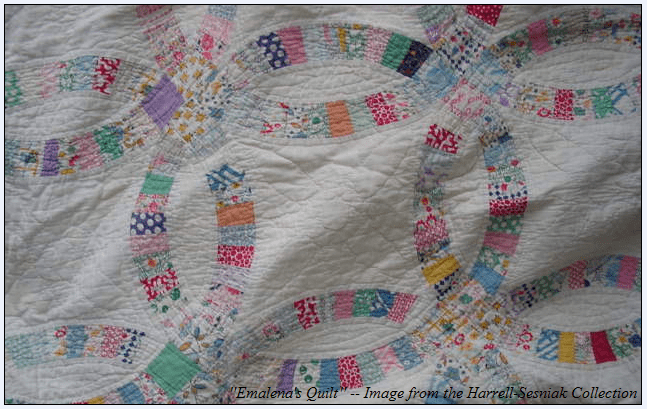
One has to assume she made a quilt for the kind widower she married. Perhaps one of her quilts “sealed the deal” with the marriage proposal. We certainly hope so!
Jacquard Coverlets
Two family treasures that came through my family were matching Jacquard coverlets.
Notice that this one, which belongs to my aunt, has the name Sophronia W. Seymour inscribed on it, along with the year 1834. Sophronia was my second great grandmother, and in 1834 would have been 20. Perhaps it was part of her trousseau, an old tradition in which items were collected for a girl to take into her marriage.
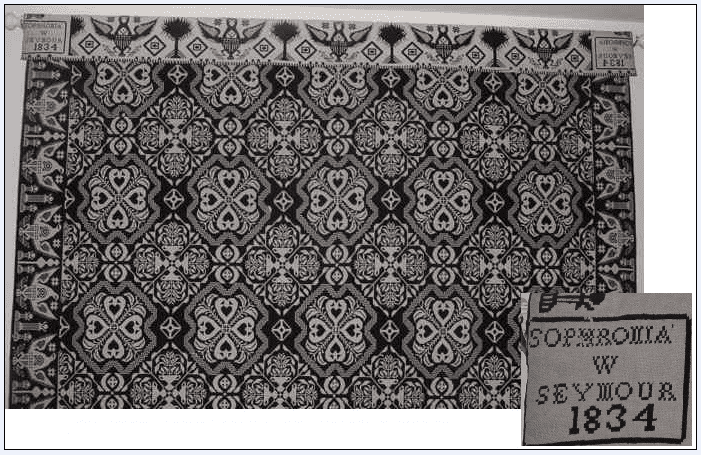
For many years, I thought that a family member had been a talented weaver – but now I know from historical research that this was probably not the case. Around 1820, a special loom was invented by Joseph Marie Jacquard which truly revolutionized the world of weaving.
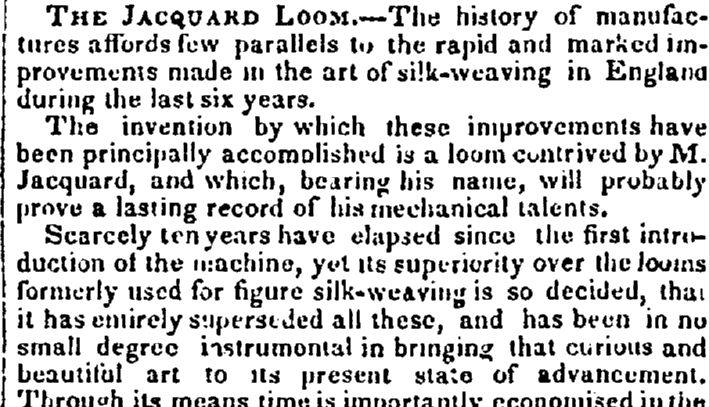
As Jacquard’s loom was programmable, it was much like an early computer. Intricate fabric patterns were made much quicker than before, and often in a double weave motif. The coverlet above, and another matching eagle and heart patterned example that also came through the family, are black on white on one side, and white on black on the other.
Not every quilt or coverlet contains names and dates – but when they do, they are wonderful genealogical gems (click this link for examples.)
Jacquard died in 1834, and it is a shame that so many people today do not realize the impact his loom had on the world.

Textile Research
Newspapers offer a fine opportunity to research heirloom quilts and coverlets. Many of the newspaper articles are rich with detail. Not only can they help you date your treasures, but you can even find patterns to help you make your own family heirlooms.
One of the earliest newspaper reports that I could find regarding a quilt dates to 1752.
Margaret Rogers, a young girl apprenticed to Alice Dodd of Philadelphia, ran away. The runaway ad detailed Margaret’s garments, along with a light blue homespun quilt that she took with her.
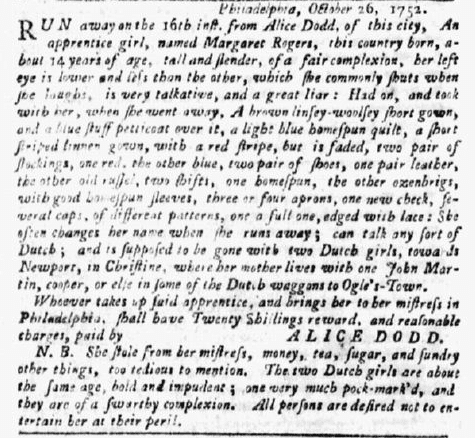
Looking through 19th century newspapers you’ll find various quilting and sewing advertisements, some even detailing the machines our ancestors used.
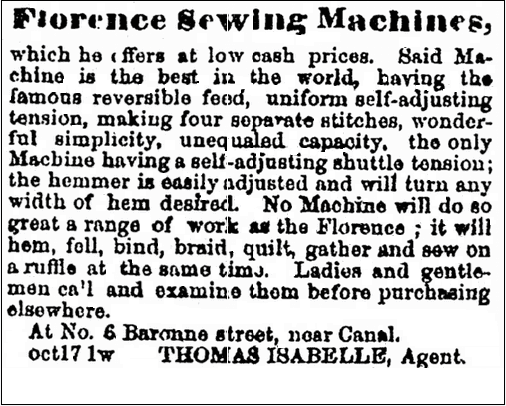
By the 20th century, quilting had become all the rage. Quilting patterns appeared in newspaper articles, including this pretty Star Center Quilt block “stolen” from a neighbor’s laundry line. News articles frequently detailed color patterns and tips to assemble the quilts. For this one, red, white and blue were suggested:
Any house w[h]ere there are many children would be apt to furnish easily the blues and whites, and even if the red had to be bought for the purpose the cost would be very slight.
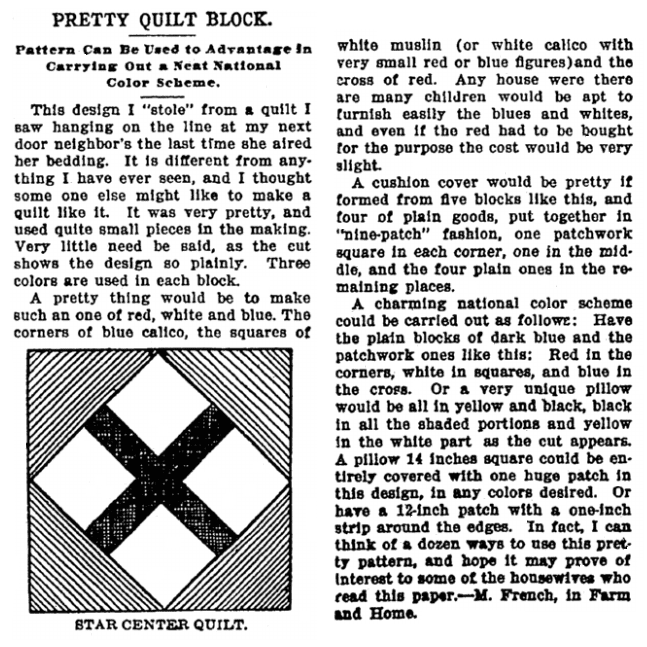
A favorite of modern quilters are patterns, of which there is no shortage in newspapers. Many of the famous Laura Wheeler designs were published, including this basket applique quilt design from 1936.
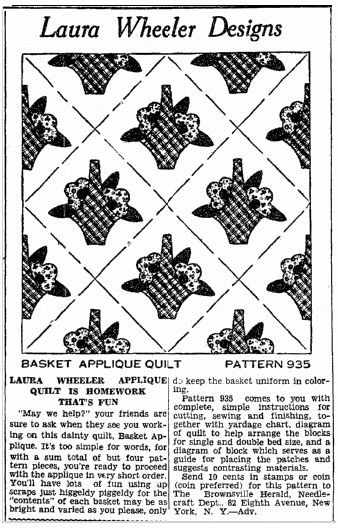
This 1937 newspaper article detailed the activities of Miss Minnie Eldridge, a home demonstration agent from Texas. She educated various Louisiana farm women on how to fashion quilts and taught them about the flower pot pattern fashionable among the mountaineers of Tennessee.
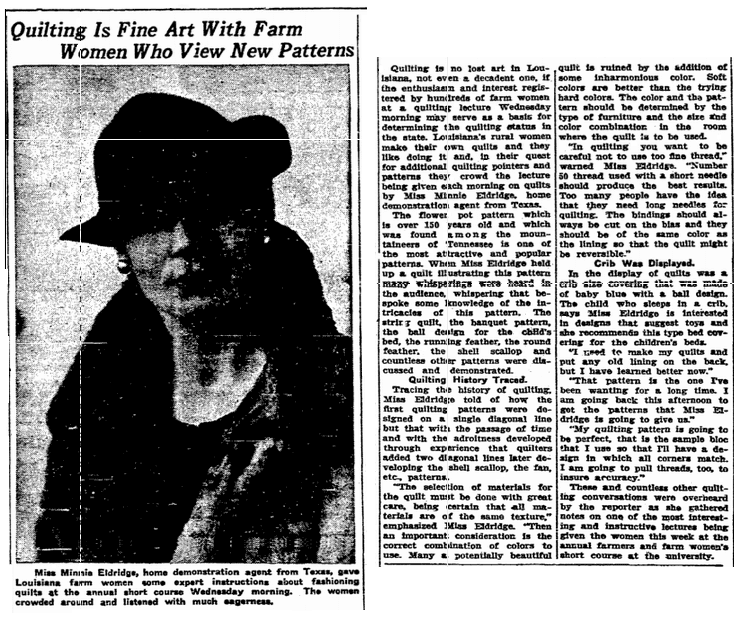
Quilting is no lost art in Louisiana, not even a decadent one, if the enthusiasm and interest registered by hundreds of farm women at a quilting lecture Wednesday morning may serve as a basis for determining the quilting status in the state.
Other Resources for Quilting Examples
Don’t forget to explore social media, and in particular Pinterest, for quilting examples. A favorite of mine is the Library of Congress, where I found this lovely picture of quilters in Gee’s Bend, Alabama.
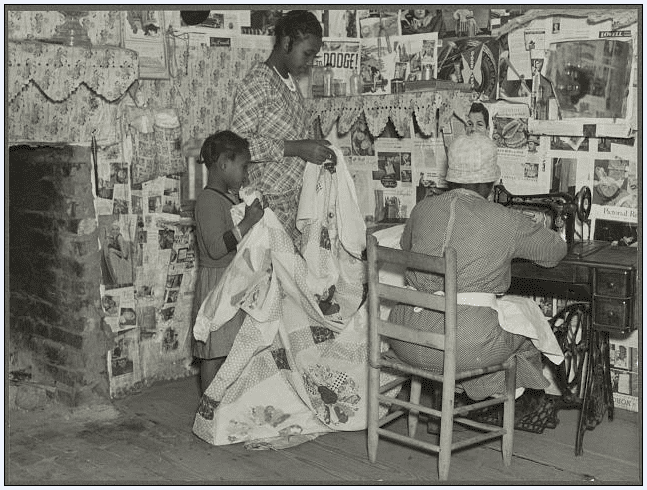
Hope this inspires you to research your textiles, quilts and coverlets in newspapers. Be sure to share your finds in the comments.
Related Articles:

My grandmother made two kinds of quilts. One was a “practical quilt”, using plain blocks of fabric salvaged from less worn parts of clothing past patching, backed by strips salvaged from sheets similarly worn, and filled with wool salvaged from old coats, good parts cut into blocks and tacked together. Generally these quilts, for household use, were tacked. The other kind of quilts were made of better cloth, whole muslin for the back and worn but serviceable woolen blankets as filling. The layers of these quilts were usually sewn, and were sold to help support the household. I suspect that is what is going on in the photo with the family all working on a patched quilt. I might add that patterned quilts came into popular fashion late, during the 19th century, when industrial weaving mills made large quanitites of fabric readily available. For middle and upper-class women, it was a means of self-expression and a hobby. For poor women, it was a means of livelihood with an opportunity for self-expression. The type of quilt, the fabrics used, and the kind of stitching can tell a story all on their own.
The word “quilt” means to sew or tack layers of cloth together. That meaning hasn’t actually changed. Patchwork came to be refered to as “quilting” during the late 19th century because of the association of patchwork designs with quilting as a means of strengthening and showing off the patchwork and applique patterns. In doing research, check the date and context, because it is quite possible that earlier references are not talking about a patchwork design, but about a simpler cover or piece of clothing that was constructed out of layers of cloth for warmth, not to display a pattern. Though women, as we always do, have a tendency to make beauty even in utilitarian objects. Those plain quilts are a treasure as well, for the story they tell hidden in the stitches.
Annie,
Thank you for sharing the lovely story of your family quilts and the thorough historical explanation of the term. I found it very interesting.
Mary
Does anyone know of a source for information about mourning quilts? Thank you.
Hi Linda,
Thanks for writing. I don’t have a specific source for mourning quilts, but perhaps a quilting museum could tell you more.
Mary